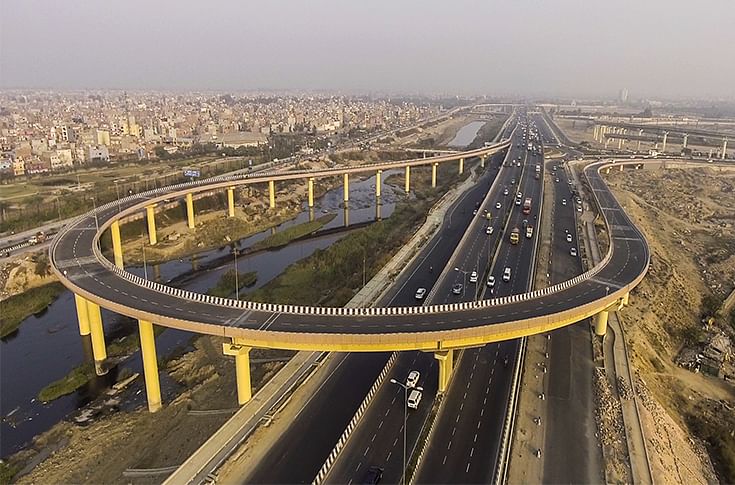Fuel efficiency hero in race to net carbon zero
Anumita Roychowdhury of the New Delhi-based Centre for Science and Environment says stringent norms are the only way to further accelerate technological innovation and achieve zero emissions.
The transportation sector as a whole is facing a unique challenge — the problem of plenty. While it took 60 long years to get the first 100 million vehicles in India, the next 100 million became a reality in just 6-8 years. Therefore, orchestrating urban mobility is one of India’s biggest hurdles now. Estimates by the IEA (International Energy Agency) indicate that vehicle ownership has nearly tripled over the last decade. The urban transport network in most major Indian cities is close to the breaking point. Traffic congestion and air pollution-related health issues have become the order of the day.

Anumita Roychowdhury, Executive Director — Research and Advocacy, Centre for Science and Environment (CSE), a public interest research and advocacy organisation based in New Delhi, says: “Environment and public health are development and market issues as well. These concerns today are going to have a major transforming effect on the global market. We expect to see a disruptive change in the automotive industry, globally.”
The recent UN statement indicates that close to 115 countries have already pledged to carbon neutrality by 2050. Net zero has become quite a buzz word and Anumita expects this to “have a strong bearing on the automotive sector. This translates into 50 percent of world’s GDP and half of global CO2 addition. So, imagine the scale of market that are going to be impacted as a result.”
India cannot remain insular to these aspects as it moves towards the next milestone on the emission roadmap. CSE's executive director feels, “India needs public and policy understanding on how to gain an edge in this change of scale (17 countries have already announced 100 percent zero emission vehicle target and phasing out of IC engines by 2040-2050). Climate change and impact of air pollution on public health globally are going to no doubt set new terms for the global market and we are part of it. So that’s the context we should keep in mind when we talk of the next trajectory from BS VI onwards.”
So, what's the road ahead?
What next after BS VI?
April 2021 marked a year of BS VI in India. While the industry achieved this in record time, what bothers many is whether the technology leapfrogging helped the core objective of sustainable mobility.
Anumita says the BS VI transition in India has instilled a great sense of confidence. “This has enabled big improvement in emissions from new vehicle fleets in India and a move up the technology ladder along with narrowing of the gap between petrol and diesel vehicles. It has enabled adoption of more stringent emission norms, particularly for diesel. BS VI adopted in 2020 is really not the final goal. The 2023 post BS VI reforms package is crucial. That will be an exercise in making BS VI itself more exacting. It will enable adoption of real world emission norms.”
For the first time in India, the focus is now shifting to real world emissions. “In a way, we see a paradigm shift in the manner regulations are going to change. With that, we have now got new-generation technology and advanced emission control systems, which are coming along with the BS VI technology,” Anumita adds.
She further emphasises the need for stricter norms as she qualifies India Auto Inc's regulation journey thus far as more of a “missed opportunity”. According to her, standards are meant to push the envelope but “the first target was so easy; industry barely had to do anything to meet that target. They even exceeded the target by a significant margin. When you look at the next standards, in moving from 129 gm of CO2 emission to 113 gm, it essentially aims to reduce emission by about 2.65 percent every year. An estimate between 2012 and 2016, by ICCT, has shown that on an average, the industry had already achieved 3.4 percent improvement annually. So, the targets are actually lower than what the industry has already achieved. After meeting the last set of standards in 2020, they barely require another 1.6 percent improvement a year to get to the 2022 targets.”
This, she highlights, is the root of the problem because “if your requirements are so low, it does not push you to advance technology to reduce the carbon impact of motorisation.” Better technology adoption will no doubt result in better efficiency gains and Anumita points out the need to actively include two-wheelers and commercial vehicles.
Speaking specifically about two-wheelers, she believes, “India has a huge advantage and opportunity to adopt fuel economy regulations.” Even though individually per unit, they use lesser fuel compared to other vehicles but “given the sheer volume and number, their demand for petrol is also enormous.” As a result, Anumita sees a clear advantage in adopting fuel economy standards for two-wheelers and CVs, especially heavy-duty ones. “International Energy Agency projections indicate that the overall transport sector fuel demand in India is going to grow significantly by 2040 and a considerable share of that will be from CVs with all the highway development that is happening. So, the heavy-duty vehicle segment is going to have enormous impact on oil demand. And they are major guzzlers. That’s why we need fuel efficiency standards for all of these very quickly, but also meaningfully.”
Role of CAFE in accelerating tech transition
In a way, regulation matters a lot in defining the terms of technology development. Therefore, “if that benchmark is made more stringent, then that will force improvement in technology. The most recent example is BS VI. When the regulations becomes exacting, the change is going to be about real-world emissions.”
She feels OEMs proving emission performance based on the real-world conditions will be a game- changer, “Now they have to ensure the durability of their emission control systems in their vehicles. This is happening for the first time in India. That's why the 2023 reforms are so important. All of these, in combination, are supposed to become more exacting and technology forcing.”
But given the cost involved and the exacerbation of the slowdown in the auto industry due to Covid, there is a growing demand from many quarters to delay it. However, Anumita does not think that is viable, “This is really not the time for us to delay our roadmap. The world is changing very fast. . . the sooner we catch up and lead, the better for us.”
“The government is giving production-linked incentives to the industry. But these production-linked incentives are industry's own corporate strategy; all of these will have to come together for a green recovery strategy. Instead of delaying it, find a method and a way to stay on course. Look at Europe . . . it is so much on course and electrification is taking off because of the fuel efficiency regulations,” she adds, while explaining the role of emission in driving technological innovation to achieve it.

Affordability and business sense are the drivers of EV adoption, which is why globally EVs are being promoted with state subsidies.
Why electrification?
Decarbonisation of future mobility is closely linked with electric mobility. —“Electrification is inevitable for various reasons,” says Anumita. As globally, the potential of IC engines is getting closer to the saturation point, any incremental tightening of emission involves a huge cost factor. In comparison, though the upfront cost of EVs is relatively high, the incremental cost of exacting tightening standards in conventional ICEs, tilts the balance in favour of EVs. “If tailpipes can achieve zero emission, you are reducing enormous emission in cities,” she explains.
However, affordability and business sense are other important factors. Anumita reasons that this is one of the reasons why world-over electric vehicles are being promoted with state subsidies. But that said, she adds, “Emerging data indicates that operational and maintenance cost of electric vehicles is much lower. The battery cost is critical in the electric vehicles and scale can bring down battery cost significantly. Ultimately, it is the TCO (total cost of ownership) of the vehicle is what matters.”
According to her, “The devil is in the design. What standards you set for fuel efficiency, will set the target for electrification.”
Old vehicles and scrappage
The other key culprit in the growing carbon footprint across the automobile industry are the older vehicles and lack of appropriate infrastructure to dispose them off. In the past few months, the finer details of the scrappage policy have been announced and a few companies like Mahindra CERO have begun operations.
However, Anumita highlights the potential problem areas in the guidelines. “There is no clear mandate at the moment and there are lot of leakages. There is no clear guideline about how end-of-life vehicles need to identified and scrapped. There is not much clarity on the exact extent of the implementation of a central policy by the state. We had hoped that this will be designed as a stimulus policy, especially for old commercial vehicles — trucks and buses — and expected a central incentive and targeted policy for the heavy-duty sector. There could have been some method of linking industry participation of scrappage of end-of-life passenger vehicles and two-wheelers with electrification. That is what I feel is an opportunity missed, especially at a time when we are looking at green recovery. "

IEA projections indicate that the overall transport sector fuel demand in India is going to grow significantly by 2040 and a considerable share of that will be from CVs with all the highway development that is underway across the country.
Looking ahead
Ground vehicles together contribute to more than 75 percent of transport emission and that in itself contributes nearly 17 percent of the world’s energy-related greenhouse gas emission. The question therefore is how can India Auto Inc make mobility a lot greener than now? Anumita believes, “The whole environment issue is no longer a soft, fringe issue. It is a serious, global development and market issue today. The moment you start setting a target for net zero and completely phasing out IC engines, it will surely have a transformative impact.”
She considers it important for Indian industry to realise and understand the opportunity that lies in new-generation regulations, “The focus therefore has to be on-
- Need for far more transparency in vehicle performance and more consumer information.
- Understand the value of combining emission and fuel economy standards.
- Zero emission transition and trajectory for electrification need to be part of a focussed industrial policy. Government needs to be a prime mover in enabling the mechanism.”
She surmises the need for proactive all-inclusive and comprehensive policies that combine market requirements with developmental issues, “an industrial agenda can no longer be delinked from the broad agenda for the future.”
As former UN Secretary-General Ban Ki-moon famously said, “We must connect the dots between climate change, water scarcity, energy shortages, global health . . . Solutions to one problem must be solutions for all.”
This feature was first published in Autocar professional's May 15 issue.
RELATED ARTICLES
How Venkat Thimaraju Bridged Mines and Machines for Daimler
From a young engineer's vision : Daimler India unleashes next-Gen trucks for India's booming construction and mining sec...
Tata Motors: From Ice Legacy To Electric Intelligence
Tata Motors has a lot riding on the newly launched Harrier EV, coming as it does on a fresh, EV-oriented software platfo...
Complete List of Cars and SUVs Tested by Bharat NCAP
Bharat NCAP has crash-tested 20 models to date, including both ICE-powered vehicles and EVs.





 04 Jun 2021
04 Jun 2021
 5372 Views
5372 Views





 Shahkar Abidi
Shahkar Abidi


 Ketan Thakkar
Ketan Thakkar


